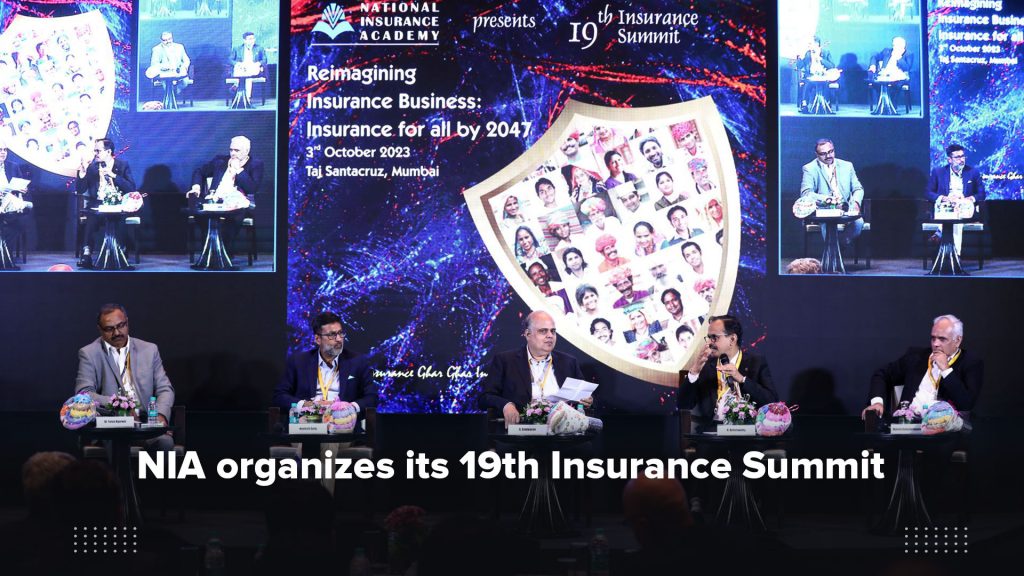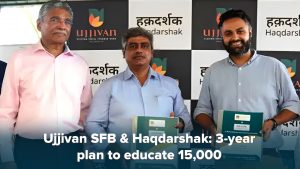A full day session packed with knowledge and insights for tomorrow’s insurance professionals:

National Insurance Academy (NIA) organized its flagship event Insurance Summit, 2023 on 3rd October 2023 at Taj Santacruz, Mumbai. The theme of the summit was Reimagining Insurance Business: Insurance for all by 2047.
In his welcome address, Dr. Tarun Agarwal, Director, NIA said that the current era is marked by economic changes, risks, and challenges, underscoring the essential need for insurance coverage. He recognized the pivotal role of data and emphasized the rise in data skills and the importance of CRM for effective customer engagement. Dr. Agarwal highlighted the need for increased Request for Information (RFI) and user-friendly, tech-driven end-to-end services. He further underlined the importance of a digital mindset, advocating for the integration of technologies like drones, robotics, and analytics to enhance risk assessment and streamline processes.
B.C Patnaik, Member Life, IRDAI, gave the keynote address, where he revealed that the life insurance sector has covered a substantial 520 million lives through initiatives like Ayushman Bharat. He identified the potential for a tenfold increase in life insurance looms, creating employment of about 3 million, and over 5 million if distribution channels are also included. He also pointed out that a mere 5% property insurance coverage and an overall penetration of 4% indicate a lag in keeping pace with the expanding economy. Health insurance is on the rise, growing at a rate of 20-22%.
The highlight of the event was a panel discussion on the theme of Leadership Vision-2047, moderated by G. Srinivasan, Member, Global Strategic Advisory Board, Agam Capital. The panelists comprised Dr. Tarun Agarwal, Neelesh Garg, MD & CEO, TATA AIG General Insurance, R. Doraiswamy, Managing Director, LIC of India, and Mahesh Balasubramanian, Managing Director, Kotak Life Insurance. Following are the key points made by the panelists.
Dr Tarun Agarwal: Having insurance in the school curriculum is a brilliant suggestion and must be done. Insurance is being taught only at post-graduation level. School level education will create risk literacy and will prepare students for the future. It will encourage a lot of entrepreneurship as well. Trust, speed of delivery are the pillars of insurance. Sandboxes should be a plug and play. There are 2500 insurtech companies and they have done so much – so why reinvent the wheel.
Doraiswamy: I slightly differ from the parameters we use for penetration. We look at values, but ideally, we should be looking at coverage. The whole thing boils down to people who are either not covered or covered inadequately. Insurance must change from push product to pull product. Distributors need a good remuneration because selling a policy requires a lot of effort. Hence, they focus on more expensive policies and as a result, low-cost micro-insurance policies suffer. PMJDY is a good move. The total number of life policies have remained stagnant over the last 6 years. New policies are sold but older policies are not renewed, people die, etc. For banks, the focus is to earn income rather than meeting the needs of customers. We need sachetized products that can be bundled with non-financial products. We must use data analytics to figure if customer’s need has changed and accordingly the product should be offered. We need to covert push product to pull product. We need to improve credibility of insurance industry. We must create greater awareness. Open architecture is wonderful but also there are dangers.
Mahesh Balasubramanian: Most of us are in the 98-99% claims settlement. In life, the claim is a yes/no decision. But for GI, it is a value computation. Even despite all the claims during covid, no insurance company went down. There are 2 aspects – service and penetration. Service has been delivered even during phase 1 and phase 2 of covid. We have worked far beyond our BCP, all thanks to technology. The regulator also blessed the digital paperless claims settlement. In 4 years, the number of agents at our call centers has not gone up as we are using chatbots, AI, IVRS, etc. Digital has helped leapfrog. Video, voice and vernacular have revolutionized the industry. In terms of penetration, there is still a gap. We need to spend upwards of Rs2 billion for 5 years to achieve the desired awareness. There is a huge gap in re-insurance. More Indian companies have succeeded in India as compared to overseas companies, as it is not easy to do business in India. Even group products, which were supposed to be easy, are now moving towards individual underwriting. We don’t have enough risk mitigants and the ability to control frauds, which is causing difficulties in re-insurance. We have 1.5 reinsurers for life insurance. We are handling a lot of regulation. Composite license can be very interesting. We can also look at FMCG and pharma industry to figure out how can we have OTC and bespoke insurance products. If regulator can come up guidelines for OTC insurance products, that will be a game changer. Risk based capital will also release a lot of capital. Insurance companies being specialized only on auto, etc, will also release capital and allow scalable growth.
Neelesh Garg: Schemes like Ayushman Bharat have given a very good template for making affordable products. It has the lowest expense ratio. It is the most digital product out there, with lowest fraud complaints. The premium is 1/10th to 1/15th of normal premium. Sometimes 2% of claims amount for 20% of the value. The 3 biggest causes of poverty are hospitalization, crop failure and death. For affordable policies, 5-star hospital stay should not be covered. There is also a trust deficit that many people feel that they have to know someone in the insurance company to get their claims cleared. The insurance industry paid Rs300 billion in claims during covid. We need simplicity around the claims process, as informing the company, filing papers and sending someone for a survey is too painful. The claims process is built around the small percentage of fraud cases. We need to use big data and AI to determine the propensity for fraud. We should give customer updates at every stage of the process through SMS, WhatsApp, etc. Also, we don’t ask all questions in one go, we should ask in tranches. Customer concerns are that insurance company may change things. We think of overseas hospitalization, but customer also things of cancelled flights, lost baggage, etc. We can give roadside assistance if vehicle breaks down. We offer home insurance but customer does not have bill of 5-year old TV when the claim arises. We need to factor such things. There are differences between claims process for heart surgery and small treatment, but our processes are built around the most complex cases. There are 2 types of investors – strategic and financial. Former have a long-term view. Industry has a gestation period of 10 years to start making money. For non-life, all licenses that are pre-2010 are making money, giving 15% ROE, which is good. No investor in the world can afford to ignore India. Regulator focus is shifting from regulation to development, and from micro-regulation to principle-based regulation. Ownership for foreign companies has been raised from 26% to 51%. Most of the concerns of investors have been addressed, and I don’t think capital will be an issue. GI is better than life at reinsurance. National catastrophe risk has been seeded out. In last 8 years, there have been $100 billion of catastrophic losses. Wherever the regulator has allowed freeing up at distribution, a lot of benefit has happened.
NIA crosses the border
 National Insurance Academy, Pune has entered into an MOU with The Africa College for Insurance and Social Protection (ACISP), Tanzania on Tuesday 10th October 2023. The objective of the MOU is to share expertise and knowledge in the insurance, reinsurance, social protection and allied fields for the African market. It will also be focusing to facilitate student and faculty exchange programs that would offer students exposure opportunity to learn from each other and engage in cross-cultural experiences.
National Insurance Academy, Pune has entered into an MOU with The Africa College for Insurance and Social Protection (ACISP), Tanzania on Tuesday 10th October 2023. The objective of the MOU is to share expertise and knowledge in the insurance, reinsurance, social protection and allied fields for the African market. It will also be focusing to facilitate student and faculty exchange programs that would offer students exposure opportunity to learn from each other and engage in cross-cultural experiences.
The MOU will not only be helpful in building a bilateral relationship between the two countries but will also help in bridging a long-lasting relationship between Indian and African people.
The MOU was jointly signed by Dr Tarun Agarwal, Director NIA and Sosthenes L Kewe, Executive Chairman, ACISP in the presence of Tanzanian President H.E. Samia Suluhu Hassan and Piyush Goyal, Cabinet Minister, Commerce & Industry, GOI. Renjit Gangadharan, Chair Professor NIA and Dr. Anselmi Anselmi, Director of Research Consultancy & International Relations, ACISP were present on the occasion.
Read more:
Kroo, a neobank, offers juicy interest rates

AI & ML Propel the Next Digital Transformation

Ujjivan SFB & Haqdarshak: 3-year plan to educate 15,000









